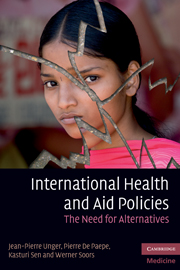Book contents
- Frontmatter
- Contents
- Preface
- Biographies
- Notices
- Acknowledgements
- List of abbreviations
- Reviews
- Introduction: Overview and purpose
- Section 1 Paradigms of international policies
- Section 2 The failure of the aid paradigm: poor disease control in developing countries
- Section 3 Impact of international health policies on access to health in middle-income countries: some experiences from Latin America
- Section 4 Determinants and implications of new liberal health policies: the case of India, China and Lebanon
- Section 5 Principles for alternative, publicly oriented health care policies, planning, management and delivery
- 12 Paradigm shifts in the health sector: mission and methods
- 13 Principles for an alternative, social and democratic health policy
- 14 Quality standards for health care delivery and management in publicly oriented health services
- 15 Principles of publicly oriented health planning
- 16 A code of good practice for the management of disease-control programmes
- Section 6 A public health, strategic toolkit to implement these alternatives
- Conclusions
- Glossary
- Index
- References
15 - Principles of publicly oriented health planning
Published online by Cambridge University Press: 06 December 2010
- Frontmatter
- Contents
- Preface
- Biographies
- Notices
- Acknowledgements
- List of abbreviations
- Reviews
- Introduction: Overview and purpose
- Section 1 Paradigms of international policies
- Section 2 The failure of the aid paradigm: poor disease control in developing countries
- Section 3 Impact of international health policies on access to health in middle-income countries: some experiences from Latin America
- Section 4 Determinants and implications of new liberal health policies: the case of India, China and Lebanon
- Section 5 Principles for alternative, publicly oriented health care policies, planning, management and delivery
- 12 Paradigm shifts in the health sector: mission and methods
- 13 Principles for an alternative, social and democratic health policy
- 14 Quality standards for health care delivery and management in publicly oriented health services
- 15 Principles of publicly oriented health planning
- 16 A code of good practice for the management of disease-control programmes
- Section 6 A public health, strategic toolkit to implement these alternatives
- Conclusions
- Glossary
- Index
- References
Summary
Adapted from: Unger J.-P., Criel B. Principles of health infrastructure planning in less developed countries. Int J Health Plan Manag 1995; 10: 113–128.
The following planning principles are designed for decision makers at central level but also for those responsible for local health systems and health districts. These principles organize the functions and relationships of health systems components (first-line health services, hospitals, and programmes). This relatively old paper has been inserted in this book because we feel the principles it offers are still relevant for strengthening health systems. The principles were formulated to make the most efficient and effective use of health care facilities and resources. They contribute to updating the concept of PHC, which re-emerged in the international policy agenda in 2006 (when the Director of the Pan American Health Organization [PAHO] took the initiative to revive this strategy) (Macinko et al., 2007).
Introduction
The highly varied efficiency in health systems and the international financial crisis may oblige MoHs to rationalize their structures of health care provision and to focus on the allocation of scarce resources to the most efficient types of facilities in their respective health systems. The aim of this chapter is to assess some of the principles for the identification of these entities, the definition of their functions and their relationships to the other elements (such as disease-specific organizations, social services and academic institutions) in the health system.
- Type
- Chapter
- Information
- International Health and Aid PoliciesThe Need for Alternatives, pp. 184 - 194Publisher: Cambridge University PressPrint publication year: 2010



